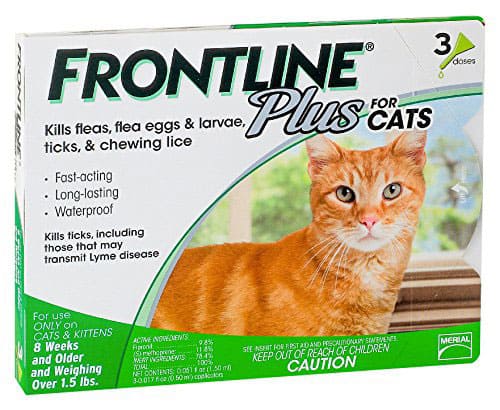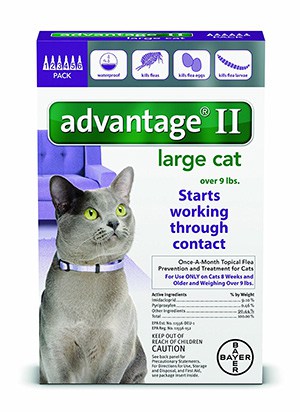The Definitive Guide to Getting Rid of Cat Fleas
Fleas are a royal pain for cat owners all over the world. As the most common parasite attacking our furry friends, these nasty buggers feast on cat blood, can jump over two feet high, and make everything they come in contact with itchy.
Not only will fleas ensure an itchy household, but they darn tough to get rid of. Cat fleas can live up to a year. Plus, these nasty parasites can produce millions of offspring in their lifetime.
Once you have fleas in your home, you’ll find pets and family members alike will be itching nonstop. These fleas go from animal to people easily. It becomes a nasty cycle infestation and itching.

Contents
Symptoms of Cat Fleas
Often, it’s not too difficult to know if your cat has fleas. The symptoms are easy to notice – in both humans and cats. If your cat shows any signs that are outside their normal behavior, you may want to search for fleas.
Common symptoms include:
- Intense scratching
- Biting and chewing their own coat
- Excessive grooming and licking of their fur
- Hair loss
- Tapeworms
- Pale gums and lips
- Way too much restlessness
- Avoiding certain areas of the home
- Red skin
- Scab-like abrasions on the skin
- Lethargy
- Specks on the cat’s fur
- Insects crawling on your cat
If you notice any of the above, you’ll want to check your cat for fleas. If you notice a number of cat fleas symptoms, then there’s a good chance your cat has the parasites covering his body.
How to Find Them On Their Skin
Luckily, if you notice symptoms of cat fleas, it’s pretty easy to find out if your cat truly has them or not. That’s the good news. The bad news is finding the fleas is much easier than getting rid of them.
Here’s how to find fleas on your cat:
- Grab a fine-tooth comb you plan to throw away.
- Slowly run the comb through your cat’s fur.
- Do a deep check around the neck of the feline and the base of the tail.
- If you see insects moving, that’s fleas.
- Small, brown shapes that move will be fleas.
- Small, white grains usually are flea eggs.
- Look at the comb. If you see excessive black spots, that’s dirt from the fleas.
If you see nothing, that doesn’t necessarily mean your cat is flea-free. However, it’s definitely a good sign. The majority of cat owners will be able to notice when their cat has fleas.
It Gets Worse
Cat fleas suck. No one denies that. However, these pesky parasites can cause more damage than a few itchy bites. Many cat fleas can lead to secondary problems for your furry friend.
Fleas left for too long on a furry friend can lead to:
- Hot Spots: If your cat chews his skin for too long, they’ll be semi-open wounds appearing on his body. This will lead to infections if not treated properly. If you see hot spots on your cat, it’s time to go to the vet.
- Tapeworms: When a cat swallows a flea, there is a decent chance tapeworms will develop. This parasite lives in your cat’s stomach and can lead to a number of health issues for the feline. If you notice tapeworms, a vet visit is vital.
- Flea Allergy Dermatitis: Some cats are allergic to the saliva of a flea. This will lead to welts and swelling on your cat’s skin. This ailment is another good reason to see the vet.
- Bartonella Infection: Also known as “cat scratch fever” – this ailment can get spread to humans. Both cat and human can suffer from fever, diarrhea, vomiting, and more when coming down with this nasty bug.
- Anemia: Cat fleas will suck the blood of our furry friends. This can cause our cats to become anemic. Things like pale gums, lower than normal body temperature, and lethargy can result.
Treatment
If your cat has fleas, then treating them should be a priority. You need to help your cat get rid of fleas as soon as possible. The faster the fleas are gone, the better your cat and family will feel. No animal or human likes to itch all the time!
Treating fleas in cats is possible and there are a variety of options available. Some of these options are certainly better than others. It all depends on your cat, your budget, and the proper timeline.
P.S: never, ever use a dog flea product on your feline! Dog flea remover can contain chemicals that can kill your cat.
Before you decide on any cat flea treatment, you should consult with your vet. Your vet will be able to help you decide on the best and safest treatment options for your furry friend.
Ok, let’s check out some of the best flea treatment options available:
Spot-On Flea Treatments
Most vets agree – spot-on flea treatments tend to be the most effective. Not only that, but these options are also quite safe and convenient. Most pet owners have better luck with topical treatments than collars, sprays, dust, and shampoos. Spot flea treatments require the owner to squeeze a liquid on your cat’s shoulders, usually around once a month.
Each brand and product will offer a little different instruction, so make sure you read before applying. Some of these treatments require a prescription, while others do not. You can buy these products at the vet, but you’ll usually pay a little markup. We found the best prices to be on Amazon, especially for Prime members. Here are a few of our favorite spot-on flea treatments for cats:
Frontline Plus

 An incredibly popular and highly effective treatment option, Frontline Plus For Cats offers flea and tick control for your feline. The product is fast acting, will kill adult fleas, eggs, and lasts for around 30 days per dose. Frontline is waterproof and claims to kill 100% of cat fleas and ticks within 48 hours of applying.
An incredibly popular and highly effective treatment option, Frontline Plus For Cats offers flea and tick control for your feline. The product is fast acting, will kill adult fleas, eggs, and lasts for around 30 days per dose. Frontline is waterproof and claims to kill 100% of cat fleas and ticks within 48 hours of applying.
The medicine is odor-free and comes with easy-to-use applicators that are child-proof. The active ingredient is Fipronil. While Frontline Plus makes bold claims, we found this product lives up to the billing. Your cat will be completely rid of fleas within 2-3 days after applying this product!
Advantage
If 48 hours isn’t fast enough, then you may want to check out Advantage. The product is another spot-on treatment that claims to kill 98% of fleas within 12 hours while stopping all biting within 5 minutes after applying. Like Frontline, each Advantage application will last 30 days and is completely waterproof. Imidacloprid is the active ingredient in this product. While there is argument over the best cat flea treatment, Advantage is the best selling treatment on Amazon for a reason.
Oral Cat Flea Treatments
Some cat owners do not like spot-on flea treatments. They believe the products are too strong and cause too much irritation for their furry friends. As such, these owners prefer to give their cats oral flea treatments when needed.
These products work differently. You add the oral treatment to your cat’s daily food one day. Your cat eats and absorbs the product into the bloodstream. This keeps the fleas from reproducing, as the active ingredient, Lufenuron, is spread to the eggs and prevents them from reaching adulthood.
We recommend two oral cat flea treatments:
- Capstar
- Program
Less Effective Options
Both spot-on and oral cat flea treatments can work well. The products we mentioned above will certainly rid your cat of fleas fairly quickly. However, there are a few other treatment options.
Some feline owners treat cat fleas by using products like:
- Flea collars
- Flea powders
- Sprays
- Shampoos
- Natural flea deterrents
…And more!
While many of these products offer stellar marketing campaigns designed to encourage cat owners to buy, we’d advise against it. All of the above have been proven to be less effective flea treatments for cats than oral and spot-on products.

How to Get Fleas Out of Your Home
Now, once your cat has fleas, you’ll have a bigger problem on your hands. Sure, you want your furry friend to stop itching, but you can’t forget…
You may start itching, too!
Not only that, but also your whole home can become infected. Fleas are great at hiding. They can stay on your furniture, carpet, and pretty much anywhere. You need to get rid of them ASAP!
If you cat has had fleas, you’ll need to do the things below immediately:
- Sweep all wood and tile floors thoroughly.
- Vacuum every inch of carpet, rug, and even your furniture. Use a new vacuum bag each time.
- Purchase a carpet spray. Spray all upholstery and carpet. Every cranny should be covered.
- Wash all bedding with hot, hot water and detergent.
- Throw away small cat toys your furry friend had been enjoying.
- Take things to the next level by fogging your home. These foggers can last up to 7 months long, which will kill fleas at every stage of life. You’ll typically need 2-3 foggers, depending on how big your home is.
- Treat every animal in your home. Not just your infected cat!
- Spray your entire yard and outdoor patio areas.
If this doesn’t work, make sure you contact a professional exterminator. Serious flea infestations can require professional help.
By following the steps laid out above, you should be able to completely rid your house of fleas. They can be pesky buggers, but with a little persistence, you’ll be flea-free before you know it.
Cat fleas can become a huge problem. The best course of action once you find fleas on your feline is to head to the vet immediately. Start spot-on treatment options quickly and get rid of fleas rapidly.
As always, it’s best to treat proactively in the spring each year. A few months of flea treatments can ensure you avoid a lot of headaches down the road. Prevent fleas, so you don’t have to treat them later!
Here’s to an itch-free furry friend!



